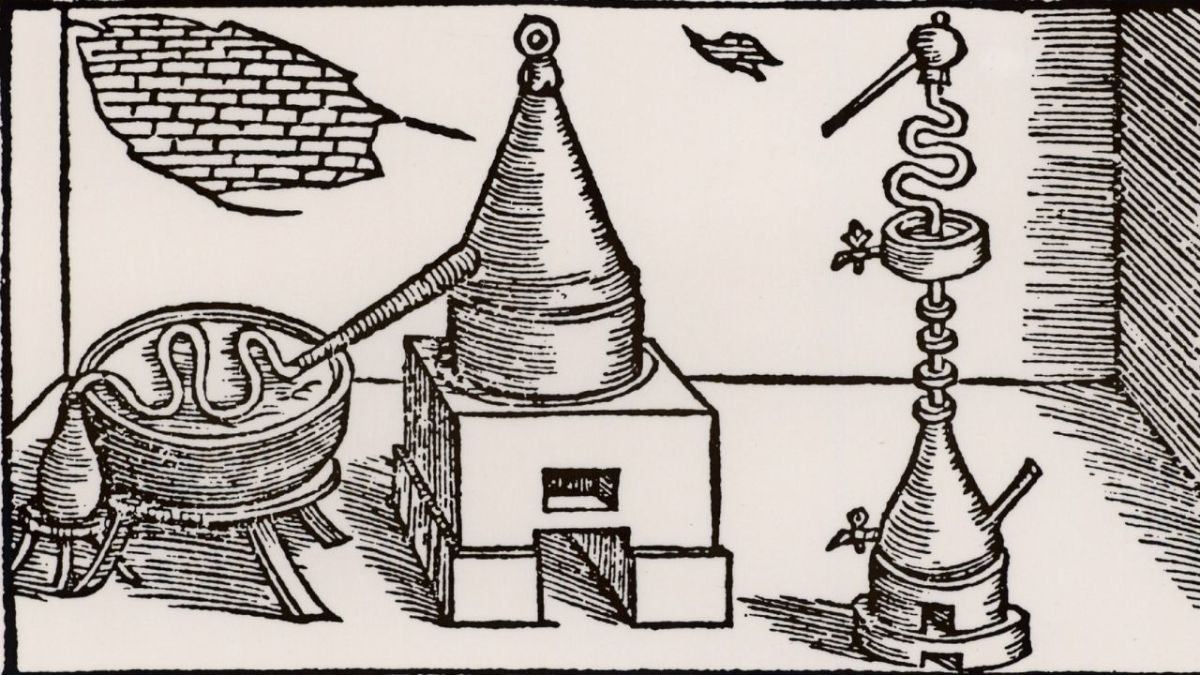
5 ways to remove salt from water (so you can drink it)
👉 The key facts from this guide
- Desalination is the process of removing salt from water to make it drinkable. There are various methods to achieve this.
- You can desalinate seawater over a fire by boiling the water and capturing the steam that leaves the salt behind.
- Desalinating seawater through sunlight (solar still) is an energy-efficient method, but it requires patience.
- It is also possible to desalinate saltwater with a plastic bottle and a tin can. This method is particularly useful if you have limited resources.
- If you are stranded on a beach and only have a gas cylinder available, you can use it to desalinate seawater.
- There are also commercial products like the Aquamate inflatable solar still, which can convert saltwater into drinking water.
In the wilderness, drinking water is essential.
But in certain environments, it can be difficult to find a high-quality water source.
However, saltwater is abundant along coastlines. Unfortunately, it is not drinkable.
The solution is to find a way to remove salt from the water.
The five processes described in this article will help you filter salt from your seawater and other drinking water sources.
Drinking water is becoming scarcer around the world, and the desalination of seawater is in full swing
Water covers approximately 71% of the Earth's surface, and only about 2.5% of it is freshwater. This naturally means that the majority of the Earth's water is seawater or saltwater.
Given this fact, I wonder: "Can saltwater be made drinkable?"
The process used to convert saltwater into drinking water is called "desalination." This process is increasingly being used worldwide to provide people with the necessary freshwater.
However, this is not only possible on a large scale.
If you are traveling in a coastal region, there is often no freshwater nearby.
Especially on islands without freshwater, this can become a necessary challenge.
Damn – a lot of water around you, but none of it is drinkable.
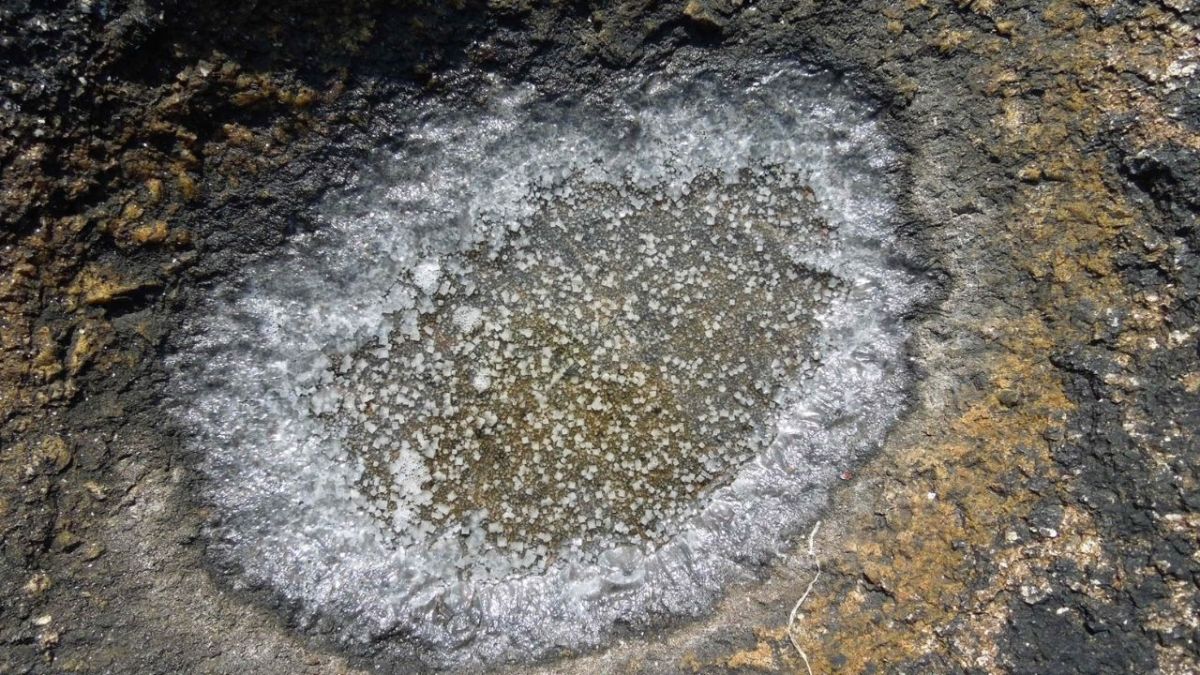
However, there are various methods for desalinating seawater that you can also implement in a survival setting.
Some require more equipment, while others can be done without much inventory.
Here you will learn how to turn undrinkable saltwater into delicious, drinkable freshwater.
What is desalination?
The process of removing salts from saltwater to produce freshwater is called desalination.
Desalination is used to produce water suitable for human consumption, sanitation, and irrigation purposes.
It is commonly used on board ships and submarines, and is becoming increasingly popular among populations to provide fresh water for drinking and other uses.
Can boiling saltwater make it drinkable?
Boiling saltwater alone is not sufficient to make it drinkable. The process of desalinating water is known as seawater desalination, and it involves more than just boiling saltwater. The salt must be separated from the water before it becomes drinkable, and boiling water will not do that on its own.
According to the World Health Organization (WHO), a water temperature of 70 °C will kill 99.999% of bacteria, pathogens, protozoa, and viruses in less than 1 minute.
Water that has been boiling at 100 °C can therefore be safely consumed – unless it is saltwater.
Why not just drink saltwater?
A quick scientific explanation: Salt forms very tight and strong bonds with water, and these bonds are not easily broken.
It therefore takes a lot of energy to dissolve the salt in water.
But can't I just save myself the energy and drink saltwater?
Of course not!
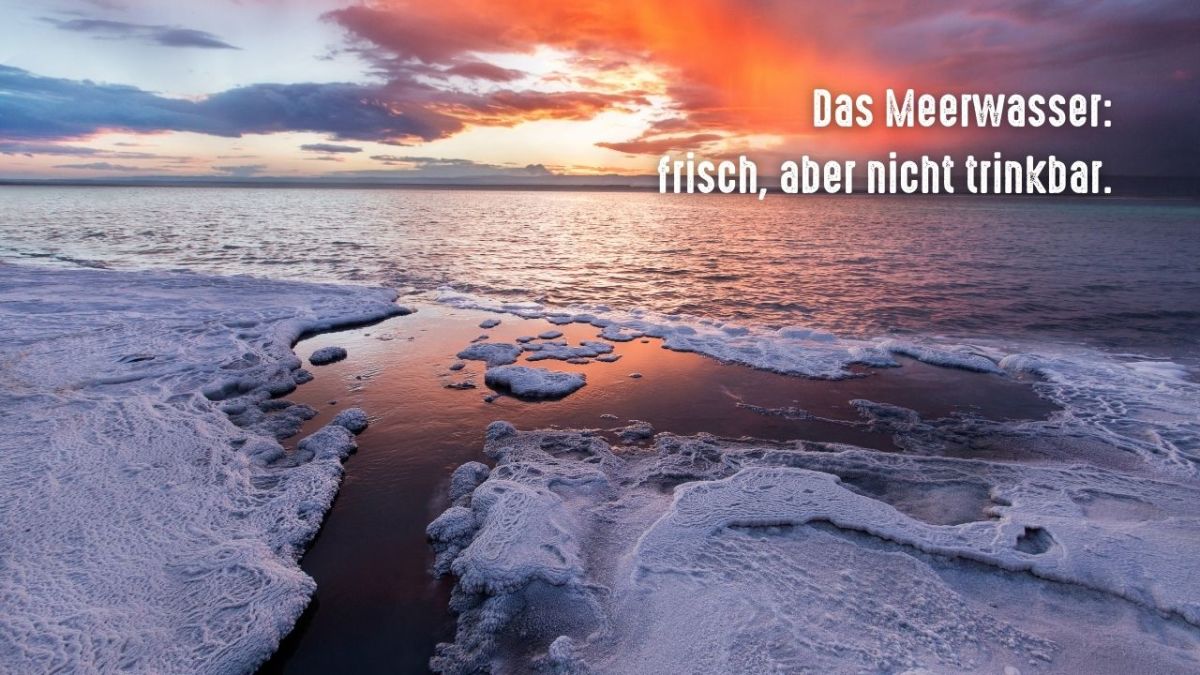
Seawater dehydrates the body. But why is that actually the case?
The process behind it is called osmosis. Salt has water-absorbing properties and thus takes water out of the body.
The body continues to dry out. Additionally, the salt needs to be excreted, putting a burden on the kidneys.
To make seawater drinkable, it not only needs to be decontaminated and cleaned, but also desalinated.
Drinking large amounts of seawater can fatally burden your organs.
As you can see, it is extremely dangerous to drink seawater. In the end, you will only get thirstier and by no means quench your thirst.
So, we need fresh water, but how?
Now I will introduce you to five methods to turn saltwater into potable water.
1. Desalination of seawater over fire
This procedure is also used by industry and requires the most energy.
The evaporation of water is used to advantage during the cooking process. Because the water that rises in gaseous form leaves the salt behind.
You just need to collect the evaporated water and you have some delicious drinking water.
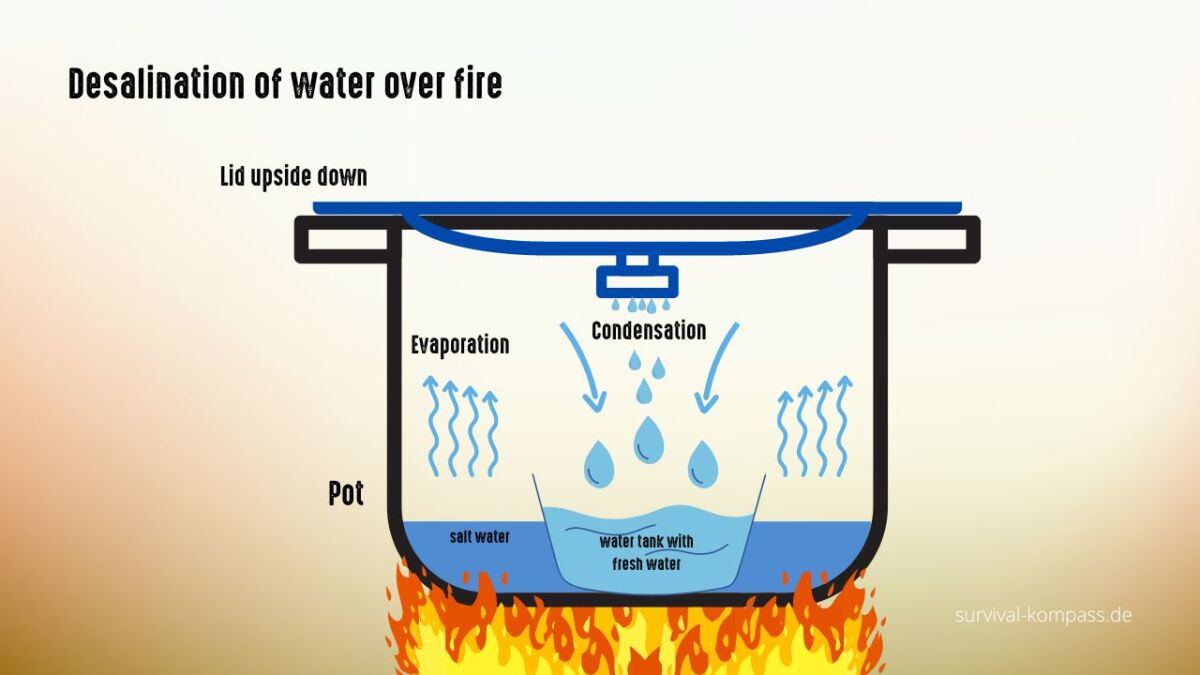
First, you require two vessels, let's say a pot with a lid and a metal cup. You catch the evaporated water in the metal cup.
Now, there are various ways to collect the condensed water. However, you start with the same steps:
- First, bring a pot of saltwater to a boil.
- The most obvious option is to place a metal cup in the pot. The metal cup must extend beyond the water level, but not beyond the pot.
- Now place the pot lid upside down on top so that the water collects on the lid and drips into the container (the lid is curved).
It is important to use either heat-resistant glass or to cook on low heat. A glass container or lid can quickly shatter over an open flame.
Therefore, I recommend using a stainless-steel lid and a container made of heat-resistant material.
If the container floats, it can be weighed down with a stone in the pot.
Alternatively, I offer you another option: this requires a rain poncho, or some type of tarp (find here 35 Tarp hacks). For simplicity, I will assume you have a poncho.
- The poncho must be hung diagonally over the boiling pot, like an inverted tent.
- The construction works as a kind of slide for the condensed water. The container is set at the end of the slide.
For this method, it doesn't matter whether the container is made of glass or not, since it will not come into contact with the flame. The first option may be more effective but requires more caution.
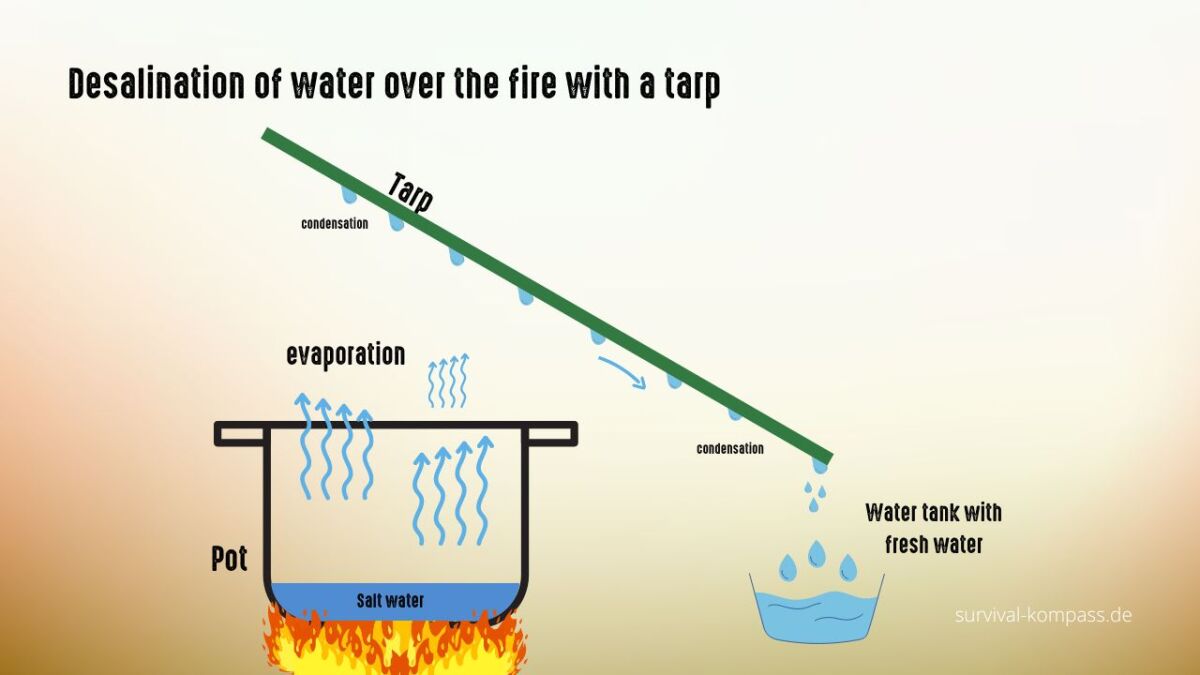
Tip: Make sure the pot lid seals tightly with the edges of the pot. Without a good seal, much of the steam will escape, reducing the yield.
In one way or another, you now have drinking water and your survival is secured!
2. Desalination of seawater using sunlight (solar still)
For this method, you need patience. The construction may seem complex at first, but it is energy-efficient and sustainable. It is perfect if you are stranded on a deserted island for an extended period of time.
However, high temperatures and direct sunlight are prerequisites.
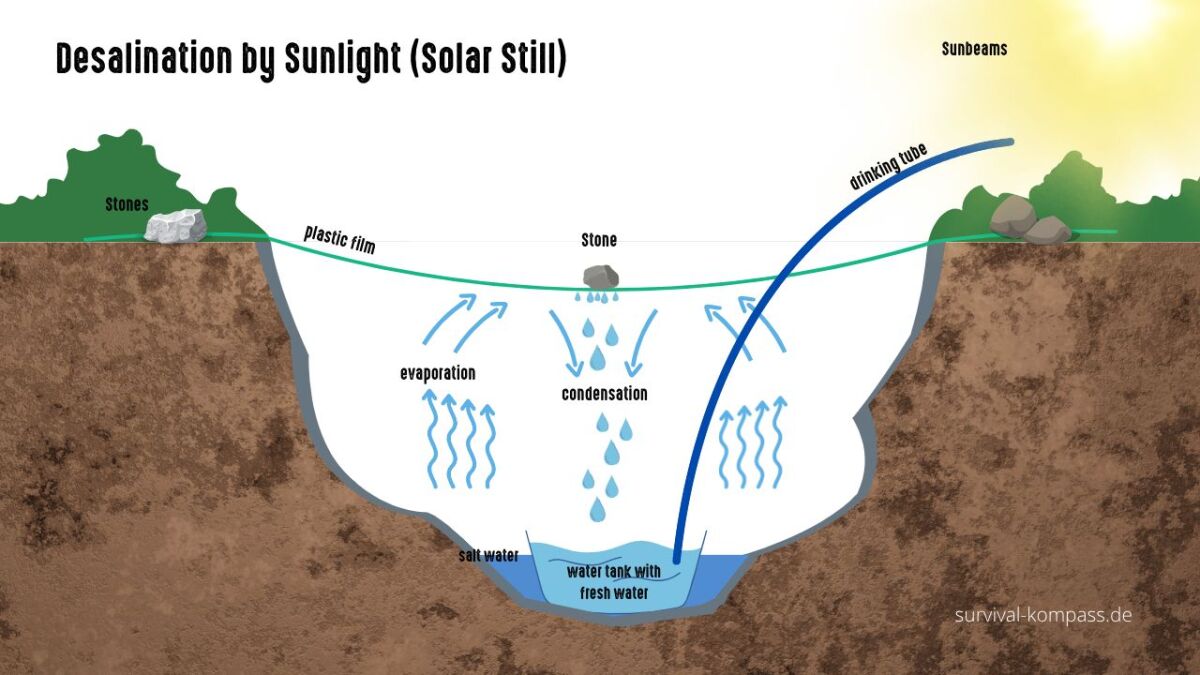
Here's a short list of materials:
- Shovel/digging stick to dig a hole (optional in sand)
- A large container for saltwater (optional)
- A small container for your drinking water
- Transparent foil to collect the condensed water
First, the legitimate question: Where does the foil come from?
In my experience, there is often a lot of garbage in and around the sea that can be used for such purposes.
This is in case of an emergency: If you are at risk of dehydration, you will most likely accept a little microplastic.
Alternatively, of course, you should already bring a tarp or foil if you know that such a situation is imminent.
Step-by-Step Guide to Building a Solar Still
- In the first step, you have to dig a hole. The bigger the hole, the more water you will catch in the end. I recommend starting with half a square meter. The depth depends on the moisture of the soil. If you have a giant container, you can also fill it with water and avoid digging the hole.
- Then you fill the hole with salt water. The water will usually seep in directly, so don't skimp on water. Even if no water remains in the pit, this method will work.
- Now, place your fresh water container in the middle of the pit (preferably a container with a capacity of 1 liter).
- Next, lay the foil over the pit and secure the sides with the excavated earth or sand. It doesn't have to be airtight.
- Now, you need to weigh down the center with small stones or other objects so that the water runs to your container and drips into it. It's like an artificial dripstone cave with just one stalactite in the middle.
In an emergency, you can also add plants or leaves. These contain water, which evaporates (evaporates) under heat and collects on your foil.
If you have more than enough foil, you can also line the entire pit with foil. This way, you can use the entire pit as a saltwater container.
Depending on the sunlight, you can drink your first fresh water after 12–24 hours.
3. Desalination by solar distillation with plastic bottle and tin can
If you have scarce resources for the above methods in a survival situation, this method could quench your thirst: once again, my recommendation is to try this only in an emergency.
When heating certain plastic bottles, microplastics or other toxic substances can be released and thus enter your drinking water.
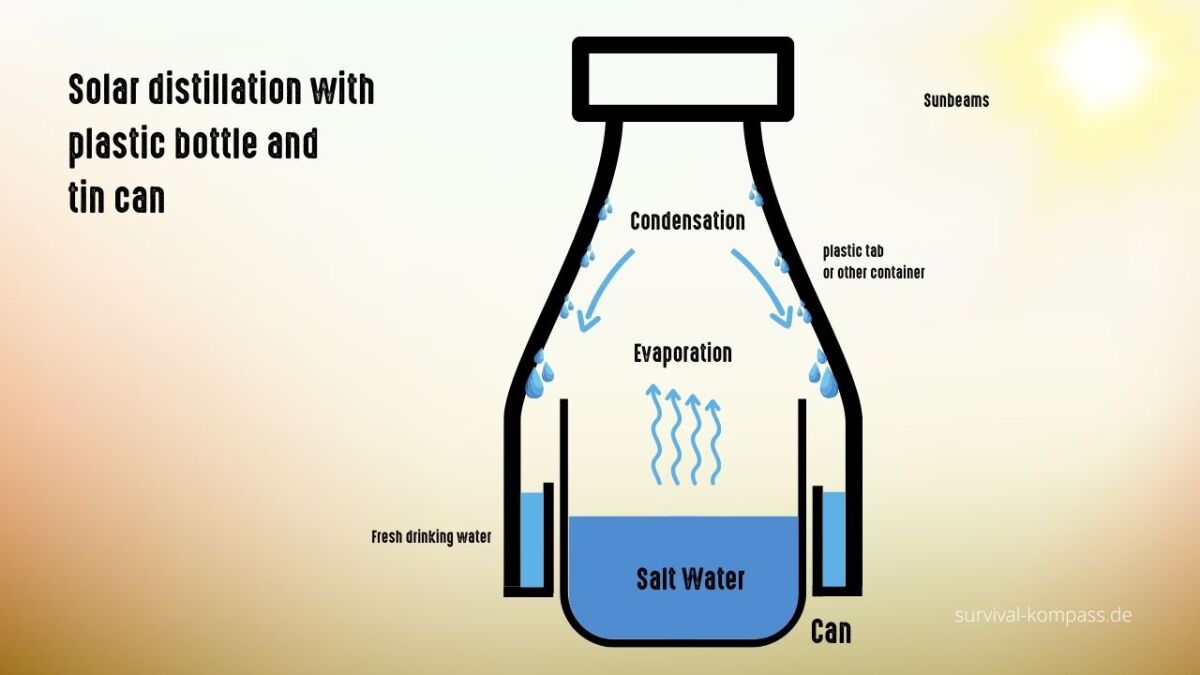
As the headline suggests, all you need for this desalination is a plastic bottle and a beverage can. The plastic bottle should be thicker than the can.
- Find the largest plastic bottle.
- Take a sharp object and cut off the bottom of the bottle
- Cut off the top part of the beverage can.
- Turn the bottom part of the plastic bottle about ¼ inward, creating a small catch basin in the bottle.
- Fill the beverage can with salt water.
- Place the plastic bottle over the beverage can.
- Station your self-built solar still in the sun. The water will evaporate and run down the outer walls of your bottle.
- Wait until the catch basin is filled.
- Enjoy your fresh water.
- Repeat the process for more drinking water.
Patience is also required here.
You now know how to get fresh water with little resources.
Avoid drinking salt water under all circumstances!
4. As a castaway, prepare drinking water from seawater with a gas bottle
Imagine being stranded on a beach without fresh water and only having your life raft and a few supplies with you.
The good news is: You can build a system from the parts of your rescue raft to turn seawater into fresh water.
The method was developed by a stranded pilot during World War II in the Pacific and actually works.
Most life rafts and inflatable boats come with a gas cylinder for inflating them with air.
Here's how it's done:
- Locate the gas cylinder and open it, allowing the gas to escape.
- Fill the cylinder with seawater, ideally through a cloth, to prevent too much sand or other residue from getting into the water. Do not fill the cylinder too full.
- Carry the cylinder back to an area where you can start a fire.
- Find a hose and sealing material, such as the leak stoppers on the life raft. Make sure the hose is free of kinks or blockages.
- Connect the hose to the gas cylinder, ideally as tight as possible. This allows water vapor to flow from the cylinder to the hose when heated, transporting fresh water.
- If you have twine or adhesive tape, use these to seal any leaks.
- Build a sandbank and bury the hose. This will stabilize the hose as fresh water flows through it. Keep the end of the hose free. Fresh water will seep out from here.
- Place a receptacle under the exposed end of the hose to collect the fresh water.
- Now, light a fire and place the gas cylinder directly over the flame. This will boil the saltwater in the cylinder. When the water boils, steam will condense in the gas cylinder and travel as fresh water into the hose.
The water collected in the receptacle is now desalinated and safe to drink.
Read also
The ultimate survival list: These 7 things you need on a deserted island - discover the 7 essential pieces of equipment for a deserted island. With our ultimate survival list and tips, you will be well-equipped.
5. Inflatable Solar Still as a Desalination Plant
If you already know what to expect and don't want to leave anything to chance, you should prepare accordingly. Especially if you're on a boat, it's worth considering.
You can get the Aquamate inflatable solar still and play it safe. This works like the above-mentioned filtration methods with sunlight.
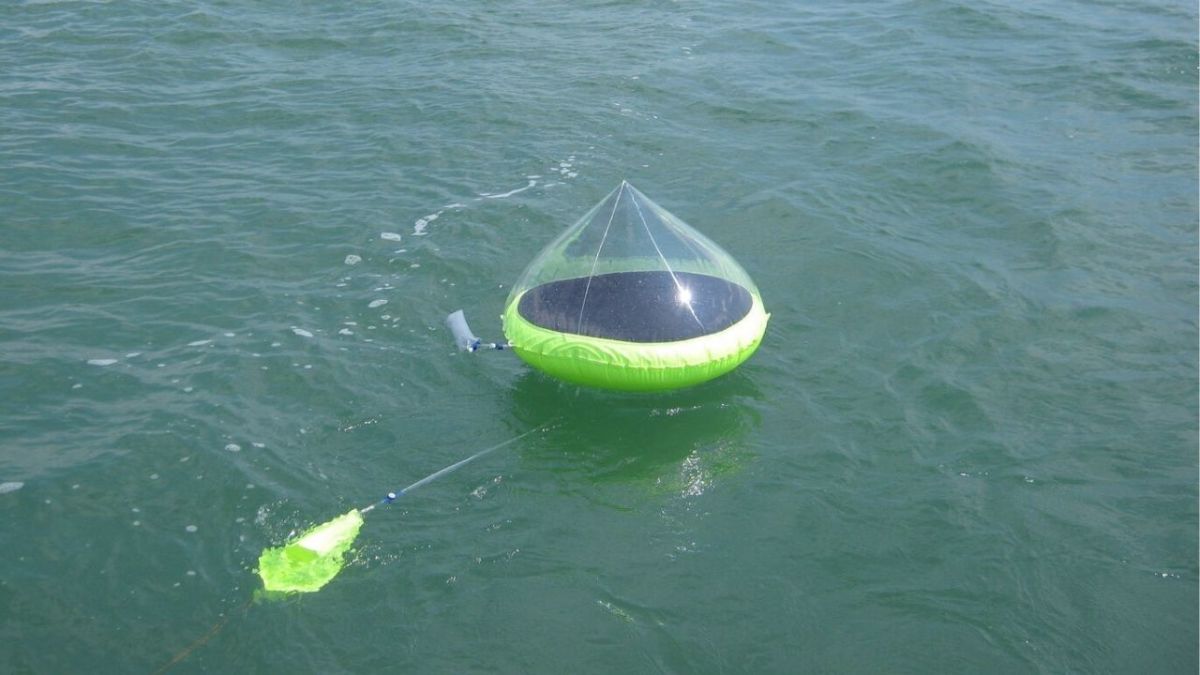
With this device, between 0.5 liters and 2 liters of fresh water should be possible per day.
Here are instructions from the manufacturer:
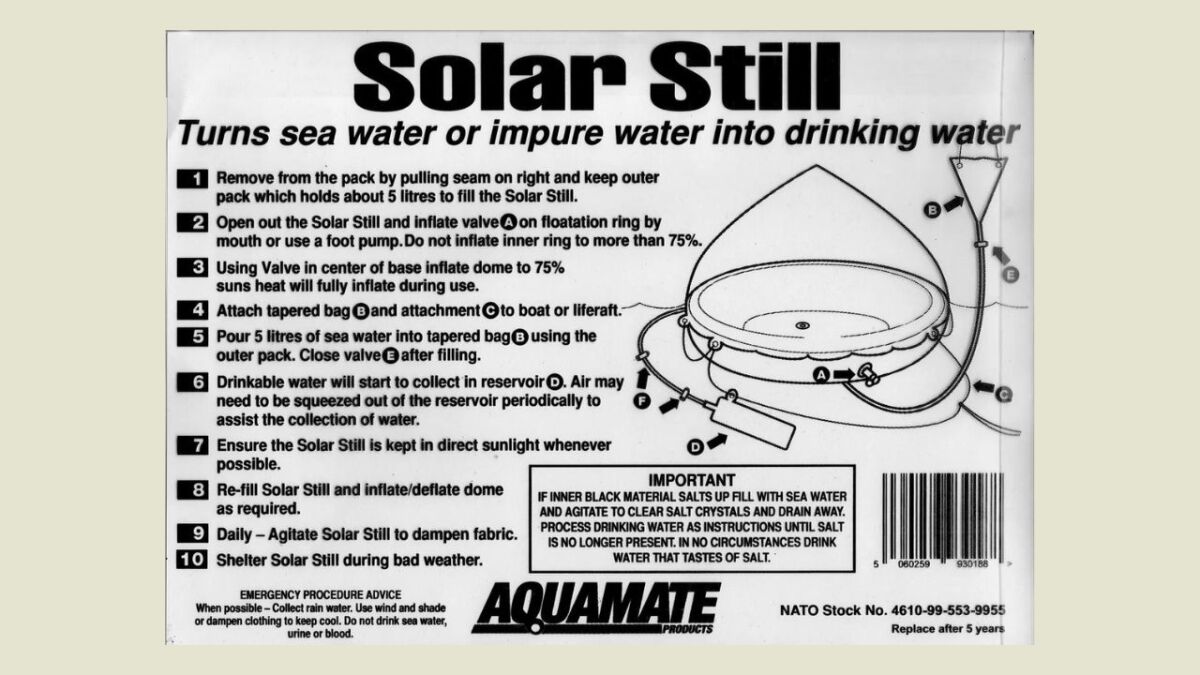
After distillation, I get distilled water - isn't that dangerous to drink?
Distilled water is not dangerous to drink, but it can be dangerous in other ways. People who drink distilled water may suffer from hyponatremia (electrolyte imbalance, low sodium concentration in the blood) since it does not contain any minerals or electrolytes. However, it takes a lot of time for this to happen.
If you are looking for detailed information on distilled water and how to mineralize it, then read my guide "How to mineralize distilled water?".
Conclusion: Drinking water should be a top priority in any survival situation.
You now know how to obtain fresh water with limited resources.
Avoid drinking saltwater at all costs!
Sea or saltwater can be converted into fresh drinking water in one of the five ways suggested above.
When you consider that about 71% of the earth is covered in water and most of it is saltwater, it is helpful to know how to convert this saltwater into drinkable water.
This process can be slow and arduous, but I recommend trying one or all of these methods.
I love using nature's resources to prepare my family and myself for emergencies. In my water guide, you will find even more ways to obtain water in an emergency.
At the beach, you have an inexhaustible resource for drinking water. All you need is heat, sunlight, and a little patience.
Good luck!

Sources for the guide
https://www.scientificamerican.com/article/why-dont-we-get-our-drinking-water-from-the-ocean/
https://utopia.de/ratgeber/entsalzung-von-meerwasser-trinkwasser-mit-problemen/
https://survivalmesserguide.de/salzwasser-trinkbar-machen/
https://www.scuba.com/blog/scuba-guides/how-to-purify-salt-water-an-essential-survival-tactic/
https://survivalfreedom.com/7-ways-to-remove-salt-from-water-so-you-can-drink-it/
https://en.wikipedia.org/wiki/Solar_still

Author of the guide
Martin Gebhardt
Hey, I'm Martin. On my blog, you will learn the basics and numerous details about living in the wild. I think survival, bushcraft and the good life in nature are the keys to happiness. Find me here on Instagram or on YouTube. You can find more about my mission on the About Me page.
Was this guide helpful?
118 people found this guide helpful.
4.93 out of 5 points (120 Ratings)
Comments (0)
This post may contain affiliate links. So if you click on the links and make a purchase, I will receive a small commission at no additional cost to you. Click here, to learn more about it.


